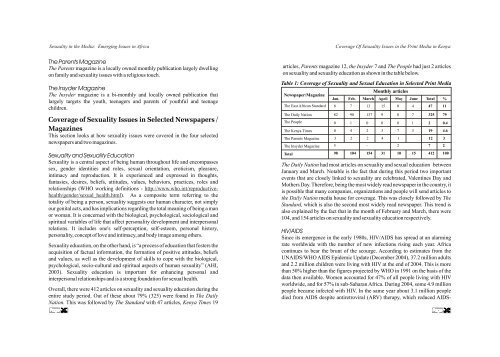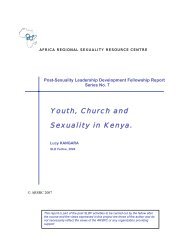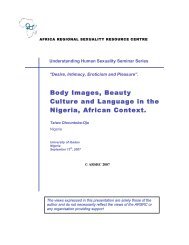Sexuality in Media: Emerging Issues in Africa - Africa Regional ...
Sexuality in Media: Emerging Issues in Africa - Africa Regional ...
Sexuality in Media: Emerging Issues in Africa - Africa Regional ...
You also want an ePaper? Increase the reach of your titles
YUMPU automatically turns print PDFs into web optimized ePapers that Google loves.
<strong>Sexuality</strong> <strong>in</strong> the <strong>Media</strong>: Emerg<strong>in</strong>g <strong>Issues</strong> <strong>in</strong> <strong>Africa</strong><br />
The Parents Magaz<strong>in</strong>e<br />
The Parents magaz<strong>in</strong>e is a locally owned monthly publication largely dwell<strong>in</strong>g<br />
on family and sexuality issues with a religious touch.<br />
The Insyder Magaz<strong>in</strong>e<br />
The Insyder magaz<strong>in</strong>e is a bi-monthly and locally owned publication that<br />
largely targets the youth, teenagers and parents of youthful and teenage<br />
children.<br />
Coverage of <strong>Sexuality</strong> <strong>Issues</strong> <strong>in</strong> Selected Newspapers /<br />
Magaz<strong>in</strong>es<br />
This section looks at how sexuality issues were covered <strong>in</strong> the four selected<br />
newspapers and two magaz<strong>in</strong>es.<br />
<strong>Sexuality</strong> and <strong>Sexuality</strong> Education<br />
<strong>Sexuality</strong> is a central aspect of be<strong>in</strong>g human throughout life and encompasses<br />
sex, gender identities and roles, sexual orientation, eroticism, pleasure,<br />
<strong>in</strong>timacy and reproduction. It is experienced and expressed <strong>in</strong> thoughts,<br />
fantasies, desires, beliefs, attitudes, values, behaviors, practices, roles and<br />
relationships (WHO work<strong>in</strong>g def<strong>in</strong>itions - http://www.who.<strong>in</strong>t/reproductivehealth/gender/sexual_health.html).<br />
As a composite term referr<strong>in</strong>g to the<br />
totality of be<strong>in</strong>g a person, sexuality suggests our human character, not simply<br />
our genital acts, and has implications regard<strong>in</strong>g the total mean<strong>in</strong>g of be<strong>in</strong>g a man<br />
or woman. It is concerned with the biological, psychological, sociological and<br />
spiritual variables of life that affect personality development and <strong>in</strong>terpersonal<br />
relations. It <strong>in</strong>cludes one's self-perception, self-esteem, personal history,<br />
personality, concept of love and <strong>in</strong>timacy, and body image among others.<br />
<strong>Sexuality</strong> education, on the other hand, is “a process of education that fosters the<br />
acquisition of factual <strong>in</strong>formation, the formation of positive attitudes, beliefs<br />
and values, as well as the development of skills to cope with the biological,<br />
psychological, socio-cultural and spiritual aspects of human sexuality” (AHI,<br />
2003). <strong>Sexuality</strong> education is important for enhanc<strong>in</strong>g personal and<br />
<strong>in</strong>terpersonal relationships and is a strong foundation for sexual health.<br />
Overall, there were 412 articles on sexuality and sexuality education dur<strong>in</strong>g the<br />
entire study period. Out of these about 79% (325) were found <strong>in</strong> The Daily<br />
Nation. This was followed by The Standard with 47 articles, Kenya Times 19<br />
Newspaper/Magaz<strong>in</strong>e<br />
The East <strong>Africa</strong>n Standard<br />
The Daily Nation<br />
The People<br />
The Kenya Times<br />
The Parents Magaz<strong>in</strong>e<br />
The Insyder Magaz<strong>in</strong>e<br />
Total<br />
Coverage Of <strong>Sexuality</strong> <strong>Issues</strong> <strong>in</strong> the Pr<strong>in</strong>t <strong>Media</strong> <strong>in</strong> Kenya<br />
articles, Parents magaz<strong>in</strong>e 12, the Insyder 7 and The People had just 2 articles<br />
on sexuality and sexuality education as shown <strong>in</strong> the table below.<br />
Table 1: Coverage of <strong>Sexuality</strong> and Sexual Education <strong>in</strong> Selected Pr<strong>in</strong>t <strong>Media</strong><br />
Monthly articles<br />
Jan. Feb. March April May June Total %<br />
8 7 13 15 0 4 47 11<br />
82 90 137 9 0 7 325 79<br />
0 1 0 0 0 1 2 0.4<br />
0 4 2 3 7 3 19 4.6<br />
3 2 2 4 1 12 3<br />
5 - 2 7 2<br />
98 104 154 31 10 15 412 100<br />
The Daily Nation had most articles on sexuality and sexual education between<br />
January and March. Notable is the fact that dur<strong>in</strong>g this period two important<br />
events that are closely l<strong>in</strong>ked to sexuality are celebrated, Valent<strong>in</strong>es Day and<br />
Mothers Day. Therefore, be<strong>in</strong>g the most widely read newspaper <strong>in</strong> the country, it<br />
is possible that many companies, organizations and people will send articles to<br />
the Daily Nation media house for coverage. This was closely followed by The<br />
Standard, which is also the second most widely read newspaper. This trend is<br />
also expla<strong>in</strong>ed by the fact that <strong>in</strong> the month of February and March, there were<br />
104, and 154 articles on sexuality and sexuality education respectively.<br />
HIV/AIDS<br />
S<strong>in</strong>ce its emergence <strong>in</strong> the early 1980s, HIV/AIDS has spread at an alarm<strong>in</strong>g<br />
rate worldwide with the number of new <strong>in</strong>fections ris<strong>in</strong>g each year. <strong>Africa</strong><br />
cont<strong>in</strong>ues to bear the brunt of the scourge. Accord<strong>in</strong>g to estimates from the<br />
UNAIDS/WHO AIDS Epidemic Update (December 2004), 37.2 million adults<br />
and 2.2 million children were liv<strong>in</strong>g with HIV at the end of 2004. This is more<br />
than 50% higher than the figures projected by WHO <strong>in</strong> 1991 on the basis of the<br />
data then available. Women accounted for 47% of all people liv<strong>in</strong>g with HIV<br />
worldwide, and for 57% <strong>in</strong> sub-Saharan <strong>Africa</strong>. Dur<strong>in</strong>g 2004, some 4.9 million<br />
people became <strong>in</strong>fected with HIV. In the same year about 3.1 million people<br />
died from AIDS despite antiretroviral (ARV) therapy, which reduced AIDS-






